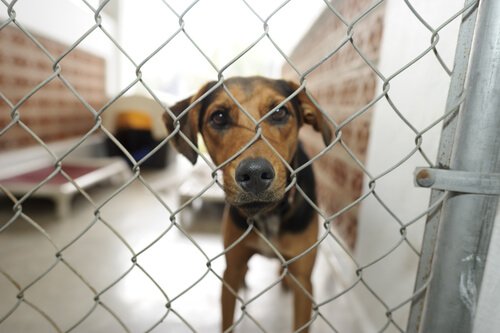Adopting an Abandoned Dog: Things to Consider

Adopting an abandoned dog gives a future to two animals: to the abandoned dog and to another one that will be able to take its place in the shelter. If you want to help fight against animal cruelty, adopting an animal is one of the best options.
Adopting an abandoned dog
You can find all kinds of dogs to adopt in animal shelters and kennels. Abandonment doesn’t discriminate among the age, breed, or color of dogs. Agencies that rescue abandoned animals are used to dealing with very different dogs because there’s no specific “type” of an abandoned dog.
Here is one of the great myths about abandonment: people often believe that if a dog was abandoned, it happened for a reason. That “reason” might be bad behavior, health problems, or a “bad breed”.
Nothing could be further from reality: thousands of purebred dogs, puppies, and animals with impeccable qualities are abandoned each year. There are also dogs with fears, behavioral problems, or mixed-breed dogs that are not the most appealing.

Every abandoned dog in shelters and kennels is unique. We can’t generalize their stories or nature. Therefore, when adopting an abandoned dog, it’s best to speak directly with the institution that has rescued them and try to get to know them without being judgemental.
Their history
Not all abandoned animals are the same. You might imagine a dramatic situation of a dog being alone on the streets for months– but that’s not necessarily the case. There are several about dogs — that have never been a stray —being abandoned at the doors of a shelter.
A few have gone directly from that situation to a foster home, so they have always lived in a home. Litters of puppies tend to grow up in shelters, so before they are adopted they have always lived in a house.
When adopting an abandoned dog, it’s useful to know the dog’s history. Who did they live with before? What were their customs? Why were they abandoned? Those questions can help you understand the dog’s nature and what their exact needs are.

Unfortunately, it’s not always possible to find out about a dog’s history. Some arrive at shelters with no record of their previous lives. Many others are found on the streets and you can only guess whether they have been alone for a long time by looking at their hygienic condition.
Their origin
In addition to their history, before adopting an abandoned dog, it’s good to know where the shelter has kept them. There are different places where they keep rescued animals:
- Foster home: the dog lives with a family in a house. You can ask the person who has taken care of the dog about their personality and habits in order to help them adapt to your home.
- Shelter with cages: the dog is alone or with a small group of other dogs in a cage. The shelter volunteers are the ones who will know them well. They can tell you about their personality.
- Open shelter: these are uncommon, but there are small shelters that don’t use cages and have a small group of free or semi-free dogs in a fenced area. You can talk to the volunteers for advice about the dog’s behavior.
Dogs living in shelters often have higher stress levels than those who live in foster homes. They might be a little more nervous or disoriented in the first few days in your home. But that’s not a general rule either.
Also, dogs living in shelters don’t have established home routines. You’ll have to work out a fixed schedule for walks and rest when you bring the abandoned dog home. If he was in a foster home, try to keep the routines they already have to make the transition easier.

In any case, there will be people who know your dog’s personality and habits. Talk to all the volunteers you can to prepare yourself at home— nervous, fearful, brave, barking, lazy, affectionate, gluttonous, etc.
Your patience and tolerance
There are several things to consider in order to prepare for the dog’s transition to your home. The process is different in each case, and depends on both the dog, your family, and your routines. But in general, you should:
- Be patient with the dog: they don’t know your house, the rules, or your family members yet. Give them one or two weeks to get used to things. Don’t scold them when they misbehave. Instead, teach them how to do it right.
- Maximum street safety: don’t let go of the dog when you go for a walk until a few months have passed. On the streets, always use a leash. If you want to give them space, choose a leash that’s 5 or 10 meters long.
- Make things easy on them: remember everything you have learned from the volunteers, and prevent the dog from doing something wrong, to improve your relationship. For example, if they’re not allowed in the kitchen, close the door. If you don’t scold them, and you make the transition easier, you’ll become a role model for them and they’ll trust you.
Adopting an abandoned dog is a good choice for any family that can afford it. It’s not always easy, and some dogs have very special needs. Consult with the shelter for help from a dog trainer who can advise you on an individual basis.
Adopting an abandoned dog gives a future to two animals: to the abandoned dog and to another one that will be able to take its place in the shelter. If you want to help fight against animal cruelty, adopting an animal is one of the best options.
Adopting an abandoned dog
You can find all kinds of dogs to adopt in animal shelters and kennels. Abandonment doesn’t discriminate among the age, breed, or color of dogs. Agencies that rescue abandoned animals are used to dealing with very different dogs because there’s no specific “type” of an abandoned dog.
Here is one of the great myths about abandonment: people often believe that if a dog was abandoned, it happened for a reason. That “reason” might be bad behavior, health problems, or a “bad breed”.
Nothing could be further from reality: thousands of purebred dogs, puppies, and animals with impeccable qualities are abandoned each year. There are also dogs with fears, behavioral problems, or mixed-breed dogs that are not the most appealing.

Every abandoned dog in shelters and kennels is unique. We can’t generalize their stories or nature. Therefore, when adopting an abandoned dog, it’s best to speak directly with the institution that has rescued them and try to get to know them without being judgemental.
Their history
Not all abandoned animals are the same. You might imagine a dramatic situation of a dog being alone on the streets for months– but that’s not necessarily the case. There are several about dogs — that have never been a stray —being abandoned at the doors of a shelter.
A few have gone directly from that situation to a foster home, so they have always lived in a home. Litters of puppies tend to grow up in shelters, so before they are adopted they have always lived in a house.
When adopting an abandoned dog, it’s useful to know the dog’s history. Who did they live with before? What were their customs? Why were they abandoned? Those questions can help you understand the dog’s nature and what their exact needs are.

Unfortunately, it’s not always possible to find out about a dog’s history. Some arrive at shelters with no record of their previous lives. Many others are found on the streets and you can only guess whether they have been alone for a long time by looking at their hygienic condition.
Their origin
In addition to their history, before adopting an abandoned dog, it’s good to know where the shelter has kept them. There are different places where they keep rescued animals:
- Foster home: the dog lives with a family in a house. You can ask the person who has taken care of the dog about their personality and habits in order to help them adapt to your home.
- Shelter with cages: the dog is alone or with a small group of other dogs in a cage. The shelter volunteers are the ones who will know them well. They can tell you about their personality.
- Open shelter: these are uncommon, but there are small shelters that don’t use cages and have a small group of free or semi-free dogs in a fenced area. You can talk to the volunteers for advice about the dog’s behavior.
Dogs living in shelters often have higher stress levels than those who live in foster homes. They might be a little more nervous or disoriented in the first few days in your home. But that’s not a general rule either.
Also, dogs living in shelters don’t have established home routines. You’ll have to work out a fixed schedule for walks and rest when you bring the abandoned dog home. If he was in a foster home, try to keep the routines they already have to make the transition easier.

In any case, there will be people who know your dog’s personality and habits. Talk to all the volunteers you can to prepare yourself at home— nervous, fearful, brave, barking, lazy, affectionate, gluttonous, etc.
Your patience and tolerance
There are several things to consider in order to prepare for the dog’s transition to your home. The process is different in each case, and depends on both the dog, your family, and your routines. But in general, you should:
- Be patient with the dog: they don’t know your house, the rules, or your family members yet. Give them one or two weeks to get used to things. Don’t scold them when they misbehave. Instead, teach them how to do it right.
- Maximum street safety: don’t let go of the dog when you go for a walk until a few months have passed. On the streets, always use a leash. If you want to give them space, choose a leash that’s 5 or 10 meters long.
- Make things easy on them: remember everything you have learned from the volunteers, and prevent the dog from doing something wrong, to improve your relationship. For example, if they’re not allowed in the kitchen, close the door. If you don’t scold them, and you make the transition easier, you’ll become a role model for them and they’ll trust you.
Adopting an abandoned dog is a good choice for any family that can afford it. It’s not always easy, and some dogs have very special needs. Consult with the shelter for help from a dog trainer who can advise you on an individual basis.
This text is provided for informational purposes only and does not replace consultation with a professional. If in doubt, consult your specialist.








